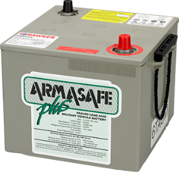Hawker Headlines
Winter 2021 Edition
Quick Tips!


Can I mix batteries of different sizes and types or from different manufacturers?
When should I replace my Hawker® Battery?
Answers to these questions and more can be found at:
<a href="https://hawkerbattery.com/resources/#faqs" www.hawkerbattery.com/resources/#faqs
Answer to question from last issue:

Is it necessary to coat my Hawker® battery terminals with grease
or silicone to prevent corrosion?
Under normal operating conditions…NO! Here’s why: Flooded/wet-cell batteries are designed to off-gas hydrogen or hydrogen-sulfide during charging. However, contained in that gas is a mist…that mist is electrolyte…and when it settles atop a battery’s lead terminals, it creates lead-sulfate! This lead-sulfate can cause problems: it’s corrosive, it adds resistance to your electrical system, and if enough of it gathers between the negative and positive terminals it can create an electrical circuit across the top of your battery…causing a “surface discharge”. So, in most cases, mechanics will coat a flooded/wet-cell battery’s terminals with grease or silicone spray to create a vapor barrier which prevents lead-sulfate…and the problems that go with it. Ok, but why don’t you have to do this with a Hawker® AGM battery? Because Hawker® AGM batteries barely off-gas, except under extreme conditions…such as application of too much charge voltage. But, voltage regulators on NATO military vehicles and off-board chargers with an AGM setting, under normal operation, don’t exceed the voltage “limit” for AGM batteries. In fact, Hawker® AGM batteries are recombination batteries…meaning the vast majority of the gasses recombine within the battery. However, a same-sized flooded/wet-cell battery can off-gas from 10x to 100x MORE!!! Think about it, if a sealed Hawker® AGM battery frequently off-gassed…IT WOULD DRY OUT!
Did you know?

that the term “current” refers to the rate of flow of charged particles (specifically, electrons…which have a negative charge) passing through a specific point on a conductive material (such as copper wiring) within a closed circuit loop system (like a vehicle’s lighting, instrumentation, or starting system). And, current is measured in Amperes…or simply “amps”.
Training:

Did you get a new battery from the SSA, SMU, DOL, or DLA? Think you should immediately inspect and test it upon receipt? Questions like these can be answered by contacting your Hawker® FSR and scheduling free onsite Battery Maintenance and Recovery Training (BMRT) for your unit mechanics/operators.

